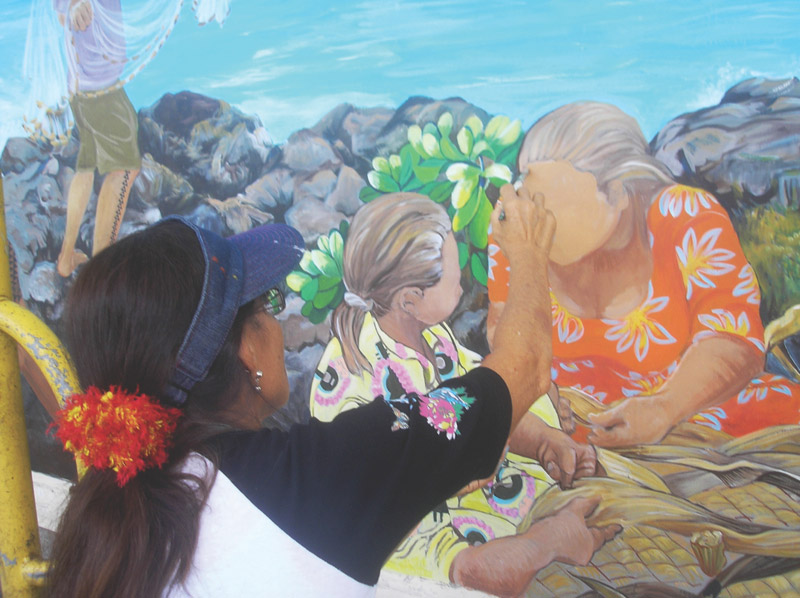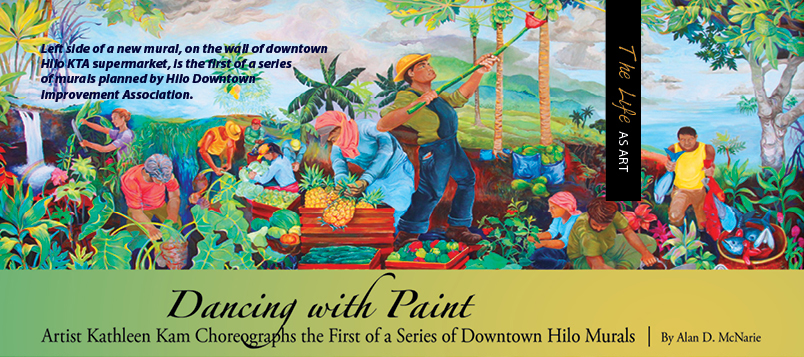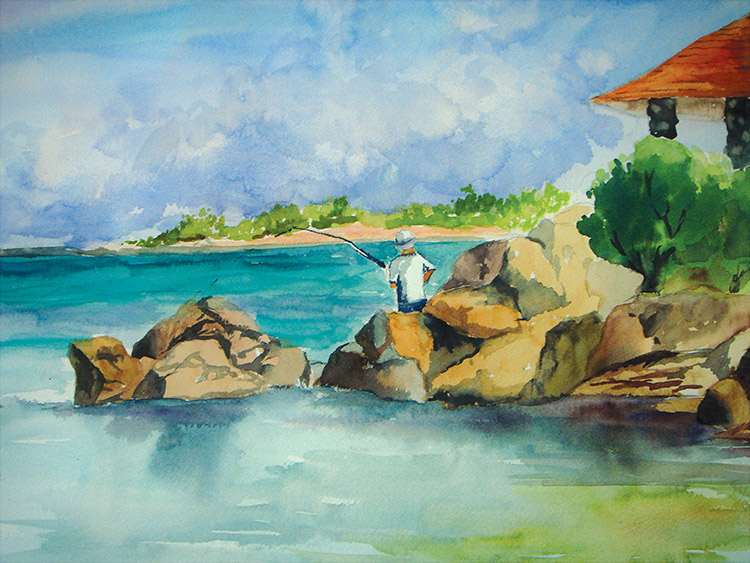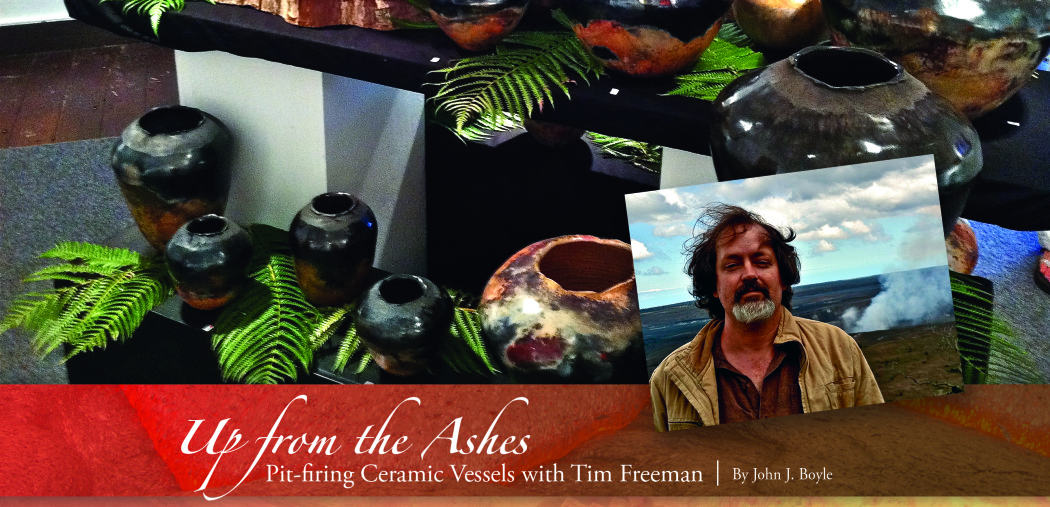
Dancing with Paint: Artist Kathleen Kam Choreographs the First of a Series of Downtown Hilo Murals

By Alan D. McNarie
“I can paint faster than I can write. I have a nickname: “Dances with Paint,” jokes Kathleen Kam, as she works in a face of a lauhala weaver that she’s painting on the wall of downtown Hilo’s KTA store. It’s a warm fall morning, and she’s hard at work, as she has been for a couple of weeks, creating what’s hoped to be the first in a series of panoramic, historical murals that will enliven downtown Hilo’s buildings.
This mural essentially combines the story of local agriculture and fishing with historic scenes of old Hilo and the East Hawai‘i Coast. Mahi’ai (traditional Hawaiian farmers) plant taro and tend bananas; a farm worker in heavy, protective clothing packs pineapples into boxes, while farmers harvest papayas nearby; women weave lauhala mats and leis; and a fisherman casts a throw net into Hilo Bay with a heavily forested, pre-footbridge Coconut Island in the background. As is usual with Kam’s murals, this one sports a wealth of carefully researched details. The beach plants near the fishermen’s feet, for instance, are accurately rendered depictions of a real native plant, the beach naupaka.
Occasionally, geography or history had to be stretched a bit to get all the details in: the lauhala weavers, for instance, wear authentic vintage aloha wear—a black, pink and yellow aloha shirt decorated with leis and violins; a green shirt emblazoned with a school of Moorish idols; an orange, floral-patterned mu’umu’u. Even though those patterns are authentically vintage to a period a little later than the overgrown Coconut Island, which is based on a postcard circa 1915-1920, a little artistic license allows Kam to cram more history—and more importantly, more of a sense of East Hawai’i’s history— into the mural’s two, 15-foot-long, 14-foot-high panels.
Kam was a natural choice to paint the first wall in this new project. In 1998, she and a team of students initiated a similar project in Ka’u by painting a mural about traditional Hawaiian culture on the wall of the Punalu‘u Bake Shop in Na‘alehu. The Ka’u project, in turn, sparked an island-wide movement that decorated walls from North Kohala to Pahoa.
Hilo got involved in the movement, big time, in 2005, when East Hawai’i Cultural Center (EHCC) refereed the painting of a whole series of murals on the plywood construction fence around the new Judiciary Building site. But when the building was finished, the fence, and the murals, came down, leaving Hilo with little public wall art besides a small painting that Connections Charter School students did in an alley next to their school.
Recently, EHCC head Dennis Taniguchi and students at the center’s Furlough Friday program added one more piece to downtown Hilo’s outdoor art collection: a mural of kids eating shave ice at Honoli’i, painted on the wall of the center’s back building, next to Liholiho Park.
Since the Punalu’u Bake Shop piece, Kam has painted numerous murals, including a depiction of rainforest flora and fauna on the front wall of the Kilauea General Store in Volcano; a pair of teaching murals at the Keauhou Native Bird Sanctuary; and a giant, 55-foot long depiction of pre-European ahupua’a life on Kamehameha School’s Kapālama Campus. But each new project presents fresh challenges. The KTA painting, she notes, had to be done on removable plywood panels so it could be taken to safety in case of a tsunami. But the biggest difference between this project and her earlier murals was the location, working amidst all the people on Keawe Street.
“I’ve never painted a mural with so much traffic through it before,” she remarks. “It’s the challenge of working in a public space and being here at 6:15 in the morning most days, including Sunday, and being a public figure and having to switch hats a lot, stopping in mid-stream to talk to people…. Sometimes I actually have to put in swimmers’ ear plugs to cut down on the traffic noise.”
But murals are, by their nature, social and sociable art; they are generally painted in public places, and a big one is seldom painted by only one person. A good mural artist like Kam doesn’t just dance with paint; she produces and choreographs a street show that results in a painting. She’s used to working with students and assistants, and knows how to get the public involved in a project. With a mural, she points out, there are jobs at every skill level. Even a passerby who’s never picked up a brush before can help lay down the base coat of paint; after that, an outline of the mural’s figures is drawn on the panels, and much of the early work is simply filling in colors between the lines. More experienced artists can help finish the figures. All told, says Kam, about a dozen people have gotten involved, ranging from casual passersby to “my mentor and former professor, Richard Crawford,” who’s there assisting her today. Her job, she says, is to “try to coordinate the color and line, unifying the 12 painters.”
The community has participated in the KTA mural at virtually every level, from research to modeling to actual painting. Community members brought in samples of hala, naupaka and kamani to serve as exemplars for the native plants. The fishermen’s Hawaiian tattoos were painted by a Hilo tattoo artist. Most of the people in the painting are based on real Hiloites, and virtually every detail of the painting has a story attached, involving some community member. Take, for instance, the little bucket of fish heads in the foreground of the fishing scene. It’s there thanks to Ryan Peters, an ag major interested in sustainable farming, who helped with the project, Kam says, from “day one.”
“He takes fish heads and mixes them with sugar to make fertilizer,” Kam explains. “He brought in a bucket of fish heads and I painted them. Then he worked as a model. I painted him holding up a fish. I drew in the fish, and then he painted the fish later.”
As for the thrownet fisherman, Kam says, “A fisherman actually came by…. He described how some of the weights are draped over the shoulder like a swag. He described it so clearly that I was able to paint it exactly as he described it.”
Hilo Farmers’ Market customers may recognize the painted figure opening a coconut with a machete; he’s modeled on a man who does just that at the market every Saturday. The lauhala weaver that Kam is working on today is based on Sarah Moon, sister of the Downtown Improvement Association’s Alice Moon and an artist in her own right. Sarah had never worked on a mural before, though; the KTA project became a teaching canvas for her. Kam started her out on backgrounds, then on painting within the lines or doing the spaces between leaves or between the human figures.
“I learned new techniques every day…,” she recalls. “It was just great, working so close to something so colorful, so vibrant…. I’ve worked a lot of stage shows, so I just loved the big scenery, the big strokes of the brush. Up close it might have looked a little strange, but if you stand back, the colors all kind of mesh.”
Another figure in the painting is modeled on Downtown Improvement Association (DIA) Vice President Jeff Melrose, who’s credited with originating the whole One Wall at a Time Project.
“We [the DIA] are not the guys who are going to build the buildings or start the businesses,” he notes. But by encouraging the wall art and hooking businesses up with artists, he believes, his group can enhance those buildings’ values, and more.
“This really was an effort to try to enhance the attractiveness of downtown, to contribute to a sense of place and identity by reflecting back the place and the culture that surrounds us,” he says.
Shortly after he proposed the project to the DIA, he says, Alice Moon happened to run into Kathleen Kam, who was an old friend. Kam volunteered to do the first mural panel for free. KTA’s newly renovated downtown store was an easy choice for the first mural; its owners suggested the theme, since it was dependent on local fish and produce, and offered to pay for the second panel.
The next site for a mural, Melrose says, is still under discussion, but he expects at least one more to get done within the next year.
When it does happen, there will be at least one recruit standing by. “I’m ready to do it again!” says Sarah Moon.
Photos by Norman Negre


